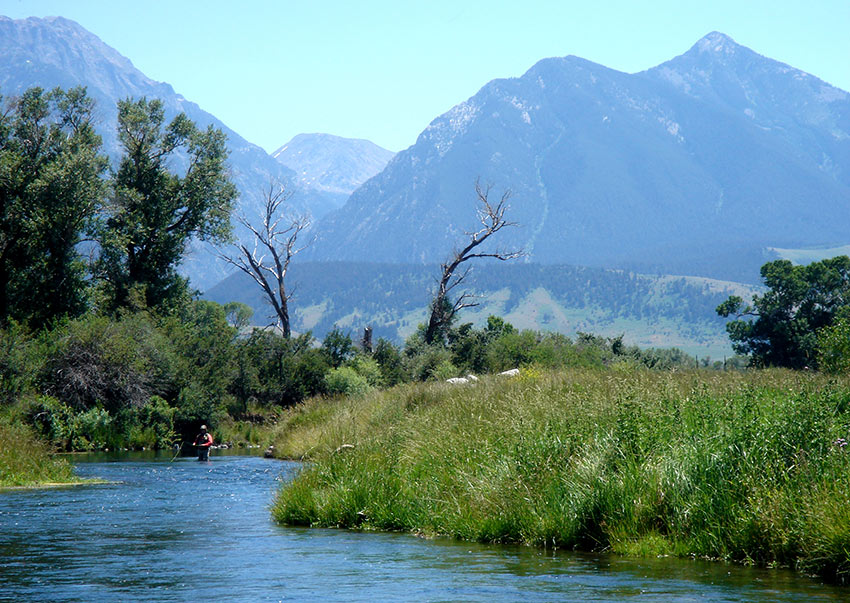
Armstrong Spring Creek, (sometimes referred to as O’Hair Spring Creek), is a classic, flat-water meadow stream that originates from the Yellowstone aquifer in Paradise Valley. Located 8 miles south of Livingston, Armstrong’s flows north and is one of the Yellowstone River’s most important tributaries. Not only does it bring cold, spring water to the Yellowstone in the summertime, but it also serves as a primary spawning ground for native Yellowstone cutthroat, rainbow trout, brown trout, mountain whitefish, and longnosed suckers.
O.T. Armstrong settled the Armstrong/O’Hair ranch in 1876. Flooded out in Missouri, O.T. decided to pick it up and move out west. He started the ranch on 350 acres with a small number of cattle. Today the O’Hair ranch runs over 1,000 head of cattle, grazing on 30,000 acres of land split evenly between deeded and leased land.
In the late 40’s Dan Bailey brought famous anglers such as Lee Wulff out to fish Armstrong Spring Creek. In the early 50’s, Joe Brooks visited the Livingston area and fell in love with the Yellowstone River and the Paradise Valley spring creeks.
Starting in the 1950’s, the local Joe Brooks chapter of Trout Unlimited managed the creek. Back then the rod fee was free and the spring creek was open to fishing to just about anyone who asked. After several published magazine articles in the 70’s however, Armstrong’s became more famous and the demand to fish the creek increased dramatically. The Orvis Company, along with a number of fishing companies in Denver leased and managed the creek from the O’Hair family.
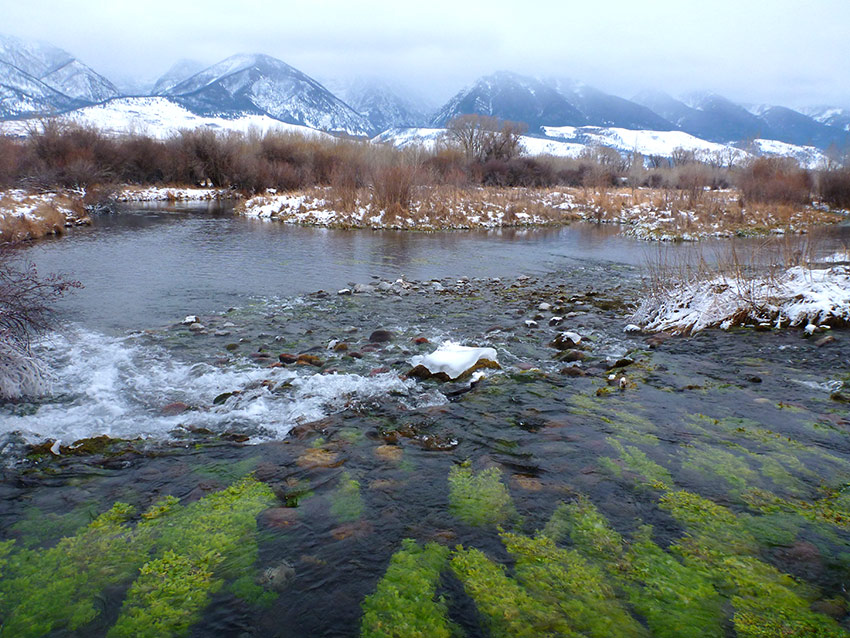
A few years later, the O’Hair family took over management of the creek and charged a small “rod” fee of $10 to fish. For all these years Armstrong’s has been considered one of the best spring creeks in the world and even made it in Chris Santella’s book, “50 Places to Fly Fish Before You Die.”
In 1996, the year of the 200 year flood, the Yellowstone river eroded a bank above Armstrong Spring Creek and cut a side channel that flowed right through to the top of the spring creek. This sent a huge amount of Yellowstone river water running through both Armstron’s and DePuy’s for the remainder of that summer. Fortunately with help from the Spring Creek Foundation, funds were raised to fill in the new channel and more repairs were made to the rip rap banks on both the O’Hair and DePuy ranches that should eliminate this from recurring.
Armstrong’s Spring Creek receives water from three types of springs, all originating from the same Yellowstone aquifer. The primary source is a very large and conspicuous spring located above the stream, close to Jerry O’Hair’s house. Many small springs are located in the floor of the stream, (channel springs), along with several marshes or high water-table areas that boarder the creek. The channel springs are easily identified in the upper portion of the creek and are recognizable where sediment is lifted up as ground water discharges, giving the stream bed a slow “boiling” appearance. The temperature of the water however, is quite cool, ranging from 48-54° F (8.9-12.1°C) year round.
Armstrong’s varies in width from 20 to 100 feet and flows roughly 4.1 miles, to its confluence with the Yellowstone. The O’Hair Ranch offers 1.3 miles of fishable water before it hits the property line of DePuy’s Spring Creek LLC. The stream continues to flow another 2.8 miles before the confluence with the Yellowstone. Fly fishing DePuy Spring Creek requires a seperate rod fee and check in.
Depending on which season you plan to fish rates will vary, ranging between $40 – $120 per person, per day. Rods are not transferable, (in otherwords you may not “split” a rod). Non-anglers however, are always welcome to join for lunch, watch, or take photographs. Winter fishing offers the least expensive rate as well as the most “elbow room.” The most popular time to fish the creeks is during late June – early July. During this period PMD mayflies are the primary hatch, and these consistent daily hatches send the fish into a feeding frenzy. Since there are so many “roll over” dates during this peak season, we suggest booking your dates 1-2 years ahead of time. If you have never had a chance to enjoy a day fishing at Armstrong Spring Creek, it is an experience that every trout angler should try at least once in their lifetime.

For reservations, you may call us at 406-222-7130, or you may call Judy O’Hair directly at 406-222-2979. They also have a cabin for rent that you can check out on line at armstrongspringcreek.com. We also reserve a number of “shop rods” every year during the busier times, so please call or e-mail us for details on availability. (Shop rods are reserved for guided trips only).
Intense hatches of midges, baetis, caddis, PMD’s, and sulphurs come off throughout the year, making for world class dry fly fishing and terrific sight fishing with nymphs. In addition to these steady and predictable hatches, there are also plentiful scuds, sowbugs, stoneflies, crane flies, and sculpins in the spring creek. Come late July through the end of September, terrestrials such as ants, beetles, hoppers, and crickets work well, particularily on windy afternoons. A mouse pattern fished near dark can produce some exciting hits, that make it worth staying out late.
Midges are the most prevalent food source during the winter months, and provide some good dry fly fishing on calmer days. In the winter it can be difficult to find a “warm” (35 – 50 degrees), cloudy day when the wind is halfway calm. On sunny, windy days, when the trout are not rising, nymph fishing is the way to go with a scuds, sow bugs, small mayfly nymphs and or midge larva patterns. Egg patterns can be deadly in the fall and again in the spring while fish are spawning.
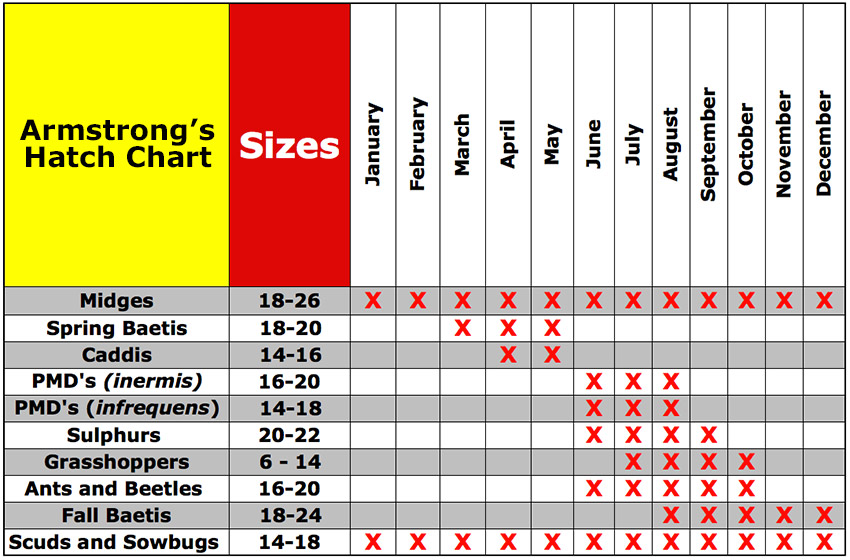
Due to the warmer water temperatures, the browns will typically spawn late in the fall and even during the winter. Please remember not to step on the redds (spawning beds) and refrain from fishing to fish that are actively spawning. This will give future generations of a trout a better chance and more fish for everyone to enjoy in the long run.
Spring and fall baetis offer some of the most spectacular, yet underrated dry fly fishing we see on the creeks all year. With less pressure on the stream, the fish excited to see the baetis, and this produces some very good dry fly fishing, with fewer refusals than earlier in the summer when the PMD and sulfur hatches are tapering off. These Blue winged olives have an olive/grey body to them with a grey wings. In general they are a size 18-20, however sometimes in the fall we also see a smaller baetis size 20-22.
During late April and early May we’ll see caddis on the spring creeks. Brachycentrus occidentalis, better known as “Mother’s Day Caddis” have an olive body with a brownish/grey tent wing. Many of these caddis spill over from the Yellowstone River, however we see caddis hatching in the creek as well, especially on lower DePuy’s.
The PMD hatch is the bread and butter of all the hatches on the Paradise Valley spring creeks. PMD’s begin in mid June. The first PMD’s of the season are the larger species of PMD’s, ephemerella infrequens. These range in size from 14-18 and drive the fish absolutely nuts. Fishing a large, easy to see PMD mayfly dun or emerger pattern is a treat, especially when you see one of these gorgeous trout come up and sip the fly off the surface.
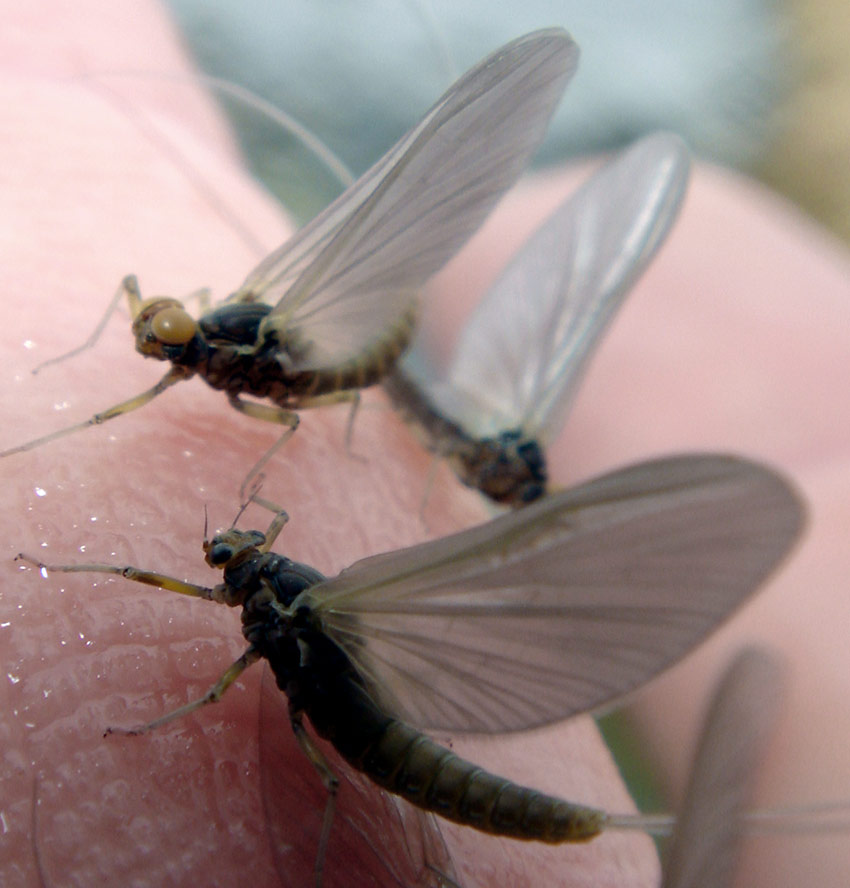
Later in July, a second species of PMD’s come off, ephemerella inermis. These PMD’s are smaller, with natural duns ranging in size 16-20. Due to angling pressure and the fact that many of the fish have been caught already by late July it is important to match the hatch and be fishing more emergers than high riding duns. During a heavy emergence, the trout become very selective and often keying in on the emerging nymphs. Having a good selection of nymphs, emergers and duns is the key to success.
PMD duns often begin to emerge around mid-morning, but there is plenty of sight fishing to be had earlier in the day with PMD nymphs and emergers. Once the duns start flying around, you’ll see lots of fish rising, especially on cloudier days. At times it feels like every fish in the stream is up, happily feeding on the surface. But once the “hatch” is over, the fish can go back down just as quickly. We can give you a good idea of when these hatches are coming off, so that you can take advantage of the situation when the fishing is hot and heavy.
Depending on the wind, the evenings can fish quite well with PMD spinner patterns. These can also work first thing in the morning, as sometimes we will get morning spinner falls. Also spent spinners from the day before will get caught up in eddies, and the fish will still be looking for them. The evenings are one of the best times to be out on the creeks however, primarily since most anglers call it a day by 5:00 and are heading in for cocktails and a nice dinner. It seems like the fish almost let down their guard and the fishing can be excellent right up until dark, when you can even catch some nice fish with small wooly buggers.
In addition to PMD’s, we also see emergences of Sulphur Duns (also spelled Sulfur) in the late afternoons/evenings. A Sulphur is actually a species of baetidae, and is pale orange/yellow in color. Unlike Easten Sulphurs, these Sulphurs are smaller than PMD’s, naturals typically range from size 20-22. Sulphurs will continue to hatch through the summer an into August, even after PMD’s have stopped comming off.
Aside from the regular hatches, scuds and sowbugs are two great year-round food sources for fish. The scuds here are an olive/grey color. They are high in protein and an easy target. The sowbugs in the creeks are more of a solid grey color, with distinct segmentation. When sampling the water with an insect net in mossy areas, you will find more scuds than sowbugs in the creeks.
If you take the time to flip over a few rocks, you will find stonefly nymphs, cranefly larva, and sculpin. We fish these patterns occasionally, mostly in the faster riffles and runs. For the most part, the fish get keyed into the insects that are hatching. When there are no hatches and nothing appears to be happening, it is worth trying some of these odd ball patterns. The browns are especially aggressive near dark and putting on a small streamer or wooly bugger often works wonders.
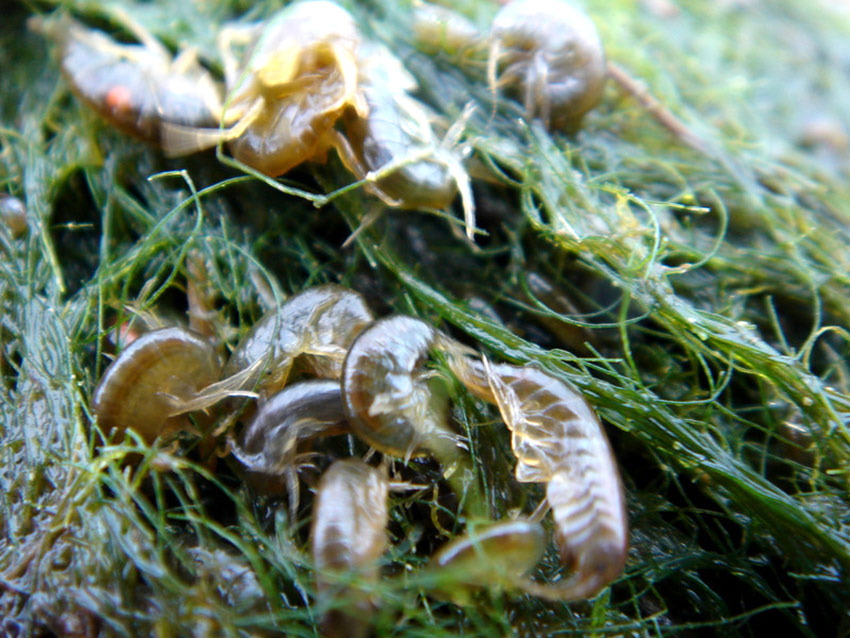
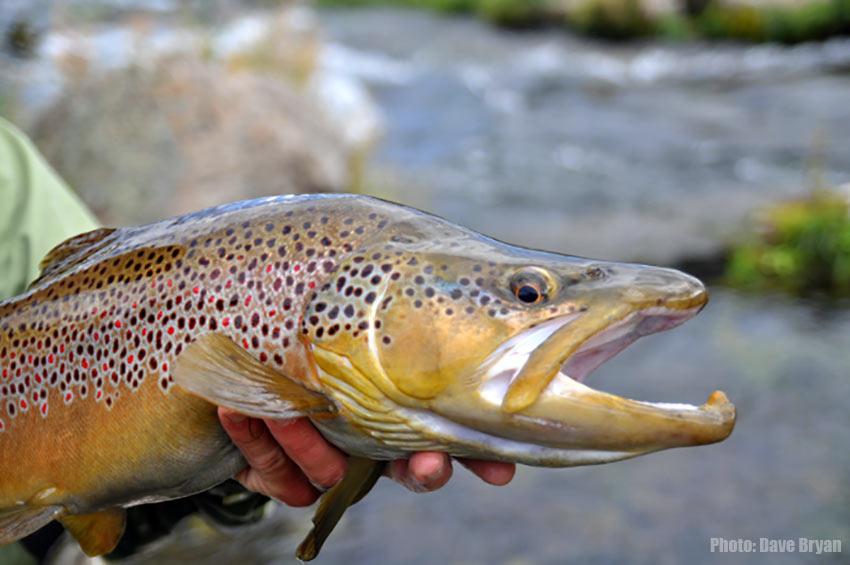
The fish in Armstrong Spring Creek are wild, beautiful fish, averaging between 12 – 16 inches. Most of the trout in the stream are acrobatic rainbows and cutbows, but some very nice browns and pure cutthroats are present as well. In certain spots, we have seen rocky mountain white fish as well as long-nosed suckers in the creek, but their percentage is much lower per mile than trout. Every season we’ll see a few trout in the 18 – 22 inch range get landed and a lot more that big that break off. Every few years or so we’ll see a monster get landed, in the mid to high 20’s.
One of the most amazing features about the fish in Armstrong Spring Creek is how brilliantly colored they are. They are easily some of the most gorgeous fish you’ll find anywhere in Montana or the world for that matter. There must be something about water or the underwater environment in the creeks that make these fish so vibrant and colorful. Each one, no matter of its size should be considered a trophy in its own right.
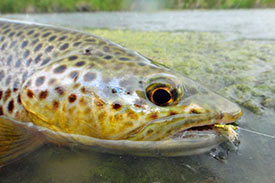
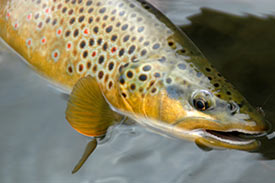
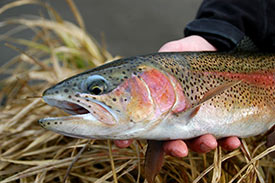
Sometimes we hear stories about anglers feeling intimidated by the spring creeks because they are “too technical.” This does not need to be the case! While the spring creeks do require a set of fishing tactics and skills, many of these can be learned in a day, at least enough for a novice angler to catch several fish while fishing with a guide. Good anglers fishing on their own can expect to hook a dozen fish or more in a day. An average angler accompanied by one of our Montana fishing guides will often catch 10 or more fish on their first day.
Although the creeks are primarily fished with dries, or a dry/dropper combo, there are many days where sight nymphing without an indicator, (or using a small yarn indicator), is deadly, and the most productive technique for catching fish. All the spring creeks encourage anglers to fish with barbless hooks, and fishing with bait or traditional spin gear is not allowed on the spring creeks.
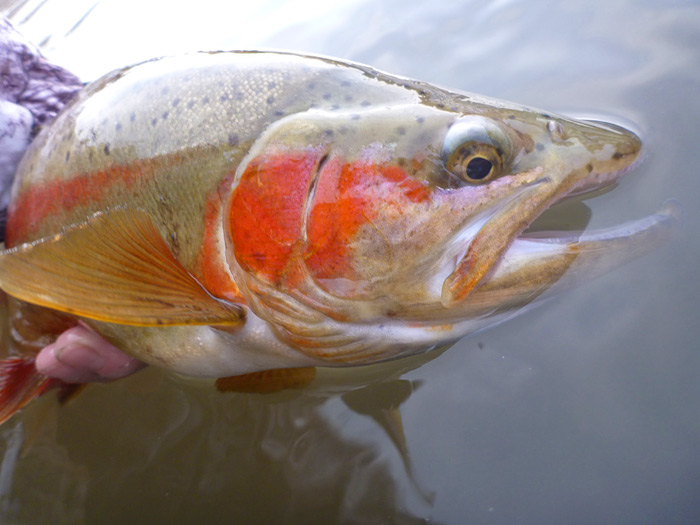
Your best chance to be successful the first time you fish the spring creeks is to hire a guide. Even if you are an expert angler, it helps knowing the best approach to each spot, the correct flies to be using, and of course someone to help you net that huge fish that has ran into the weeds after hooking it. The Montana fly fishing guides we book are all seasoned veterans on the creeks and are able to get even total beginners into fish. Not only will they teach you techniques to make your day successful on the spring creeks, but more importantly these same techniques can be used on other waters, making you a better angler.
The upper section of Armstrong’s, (above Jerry’s house), is much slower than the rest of the stream. There are only a few small riffles in this section, so you tend to see fewer mayflies like beatis or PMDs, however during the right conditions they do come off. There are some larger fish, (16-20 inch range), in this section, however it is considered to be the slowest section with the least fish per mile. But with fewer anglers up there, it can produce some very good fishing.
Sometimes in the late summer and fall the upper section will get mossy. The good news is that it deters many people from fishing it, the bad news is that it can be tricky to get a good drift and you often find yourself cleaning moss off your flies. Due to the amount of silt in the upper sectoin, there are fewer mayflies, and midge larva patterns typically work better in this upper water. Sight fishing to individual fish with small copper nymphs and other good midge larva patterns can be deadly.
The uppermost section of Armstrong’s holds very few fish, but on occasion you can find larger fish hiding from the crowds. The view, with the high Absaroka mountains as a backdrop, is breathtaking. Anglers who enjoy walking will appreacite this section regardless of how many fish are seen or caught.
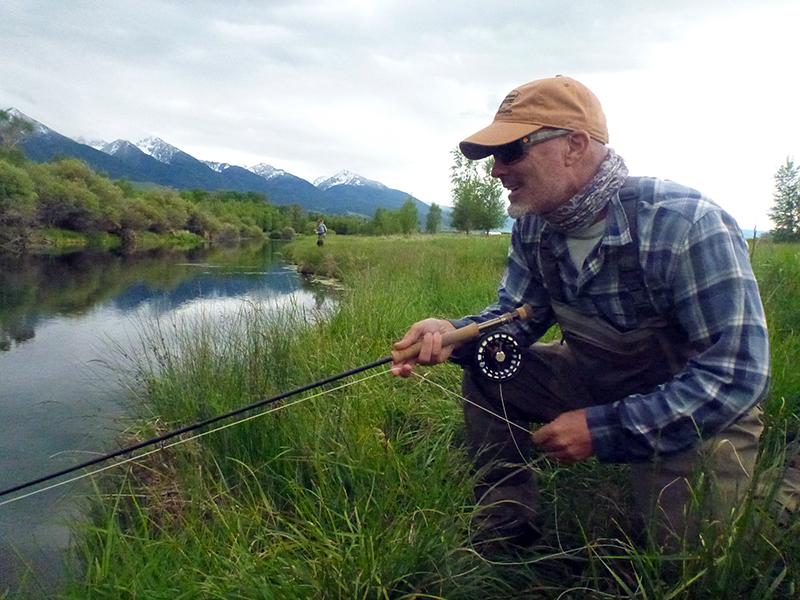
From the main spring down to the diagonal riffle is considered the middle section of Armstrong’s. The diagonal riffle is located directly across from the main parking/lunch area, (the main lunch area has the property’s only official bathroom with a sink, the rest are clean porta-potties). The middle section of Armstrong Spring Creek has the most number or riffles, hatches, and fish. Consequently, it is also the most popular section to fish.
Below the main springs, the corral area is another popular lunch spot with picnic tables. There is a nice island above the culvert in this section, which is fun to fish from. There are also some real pigs swimming around the back bay to the SE of the island. These fish are very smart and big, so when they finally do eat your midge larva or mayfly pattern, they do their best to break you off in the weeds.
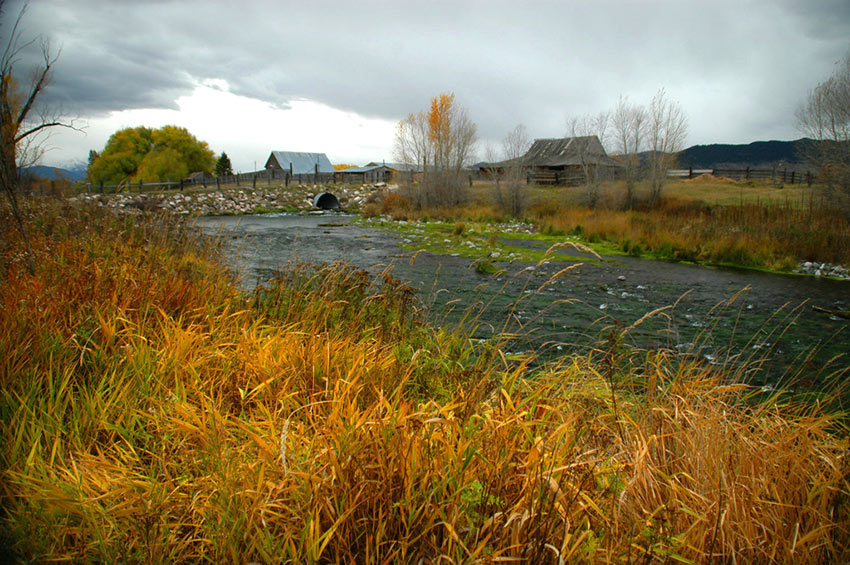
Below the culvert, the big rock section has some of the deepest runs on the property. The number 2 riffle below the big rock is probably second most popular riffle on the property, after the diagonal riffe. This riffle is best fished with a down and accross drift.
The diagonal riffle is one of the most productive fishing runs in Montana. The fish stack up in this water, especially if a hatch is in progress, and turn on like a light switch. It is hard to guess how many fish are in the diagonal riffle at one time, but when a good hatch is in progress, it seems like 100-200 fish is not far-fetched. The diagonal riffle is roughly 50 yards in width, but the fish will stack in below it for several hundred yards as well. Many times while fishing the diagonal riffle you can look downstream from your feet and see big fish have moved in, eating the nymphs that you are kicking up by wading.
From the diagonal riffle down to the DePuy’s boarder is considered lower Armstrong’s. This section has some deep holes here and there and holds some of the largest fish we’ve seen in Armstrong’s. The fish in this section are very spooky however, and bright days make the fishing very difficult, especially with dries.
There is also a lot of pea-sized gravel in the lower section, making it a prime spawning ground for rainbow and cutthroat trout in the spring. In the fall and late winter, brown trout will use the same gravel to spawn. It is important not to walk on the gravel in this area during spawning seasons, but to fish only from the edges. It is also considered unethical to fish to fish that are actively spawning. Taking these propper precautions will allow future trout a better chance to be born, hatch, and grow – meaning more trout for everyone to enjoy later.
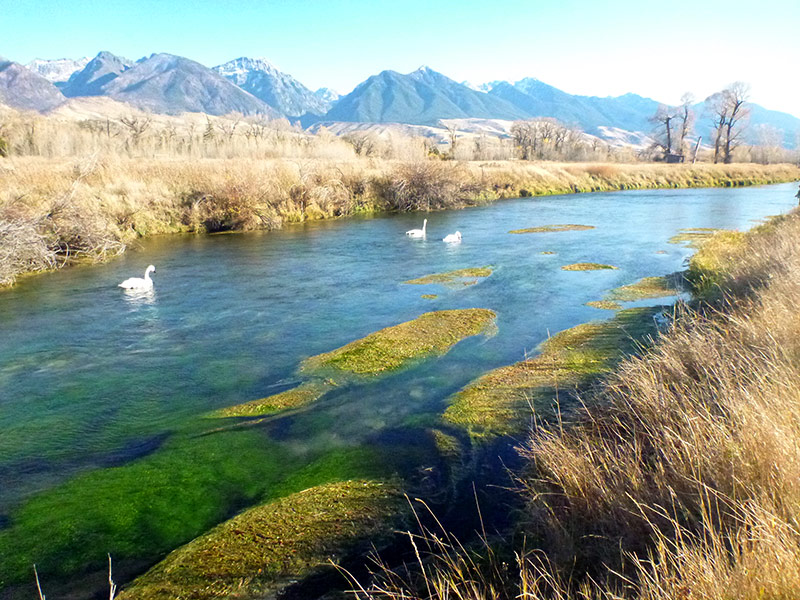
The best rod to bring to the spring creeks is a 3-weight or a 4-weight. A 3 or 4-weight rod will not only make a more accurate and delicate presentation than a 5-weight or 6-weight rod, but the thinner line also allows you to make more delicate presentations and get a better drift. In addition to a more flawless drift, a 3 or 4-weight rod does a better job protecting light 6X and 7X tippets.
Some of our favorite rods for the spring creeks include the Sage 389 LL, the G.Loomis NRX LP 8’8″#3, the G.Loomis NRX LP 9 ‘#4, the Tom Morgan Rodsmiths 8’#4, the Hardy Zephrus 8’6″#4, the Winston Pure 8’#4, and the Winston Pure 7’6″#3. All of these rods have fantastic feel and would be the perfect tool to have in your hands at any of the spring creeks.
You can also check out our 4-weight shootout to have a look at other 4-weight rods.
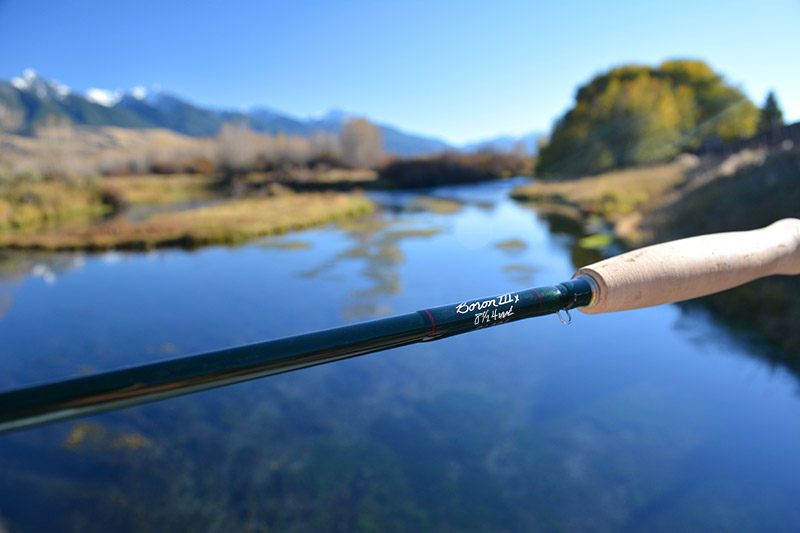
A standard click pawl reel works very well and our favorites are the Ross Colorado LT and Galvan Brookie. These are reels you must palm to apply more drag pressure. Most anglers prefer a light reel with a smooth, adjustable drag. The trout here do not run very far, (although the may take you into log jams, weeds, or rocks to break you off). One of our favorite freshwater reels is the Galvan Torque. They are light yet durable and have one of the widest ranges of drag of any reel on the market. This means you can really dial in your drag for 5X to 7X tippets.
Check out the 5 weight Reel Shootout to see why the Galvan Torque won. Of course, for a 3 or 4 weight rod, you’d want to get a T-3 or T-4 size instead of the T-5.
For lines, you can choose to fish either double taper lines or weight forward lines. Many people like the feel of a double taper line on the softer rods listed above (the Sage LL, Tom Morgan, and Winston rods) and a weight forward line on the faster rods listed above (the G.Loomis NRX LP, Hardy Zephrus, and St. Croix Imperial). While some anglers may tell you only a drab color line like olive or dark grey will work better on the spring creeks, we know from experience that bright optic green lines and even bright orange lines work as well, especially when you are using long 12-foot leaders. For double taper lines, we like the 406 DT fly lines. For weight forward lines our favorite is the Scientific Anglers Mastery Trout lines.
We are lucky to be one of three fly shops in the US to carry René Harrop patterns, tied by them personally. These flies, whether you choose a nymph, short wing emerger, sparkle dun, comparadun, no hackle, or spent spinner, are the highest quality flies you’ll find anywhere in the world. Each fly is shadow box quality and more durable than the typical import flies. Many customers who are unfamiliar with these amazing flies raise their eyebrows at the $3.95 per fly price tag, but they are worth every penny. Those in the know buy as many as they can while we still have them in stock, since we are very limited in the number we can offer for sale each year
Again, we highly recommend getting a guide your first couple times fishing the spring creeks, but if you would rather try fishing on your own, stop by the shop and we can get you a map as well as a few of the flies that are working for that time. We are always happy to help anglers pick out the right flies, and we will take the extra time needed to get you set up right and insure you have a fun and productive day on the water.
During the winter fishing nymphs, leeches or streamers you can often get away with 4X tippet. When insect hatches are occurring – spring through the end of September, you’ll need to go down to 5X, 6X and even 7X to get better drag-free presentations. We know some anglers who even fish 8X, however many of these fish hooked are lost in the weeds and with a fly still set in their mandible. Most of the time strong 6X and 7X fluorocarbon tippets are the way to go. We don’t encourage using 8X as it takes most anglers too long to land the fish, which can have a negative effect on its survival.
Since the spring creeks are so clear, we prefer to use fluorocarbon tippet rather than monofilament tippet. Yes, they are more expensive, but they are more invisible underwater. TroutHunter or Seaguar GrandMax are our two favorite brands for fluorocarbon because they are extruded with a double structure fluorocarbon. The inner fluorocarbon is very stiff and gives you your tensile strength while the outer fluorocarbon is softer, allowing you to tie better knots than don’t cut through mono or into the fluorocarbon itself. For more information on tippet check out our Tippet Shootout.
For leaders, we recommend either a standard 12′ 6X Rio knotless leader or one of our Yellowstone Angler hand-tied 12′ 6X leaders. These are tied with nylon tippets, but we have found that using a fluorocarbon tippet like Trouthunter works even better. Using two to three feet of fluorocarbon tippet allows for better presentations, getting the fly and tippet to move more freely with the tiny micro-currents we often find on the spring creeks, giving you a better drag-free drift.
If you plan to use three feet of fluorocarbon 6X tippet, yet have a 12-foot leader, the easy way to do this is to buy a 9′ 5X monofilament (co-polymer) leader, then add in the 3 feet of fluorocarbon tippet, ending up with a 12-foot leader. Expert casters may be able to handle even longer leaders in the 14 – 16-foot range. Once your tippet decreases to below 15-20 inches, (from changing flies or a break-off) you should take the time to tie in another 36″ section of tippet in order to get a better drift.
In the cold water of the spring creeks, most anglers choose to wear waders, even during the middle of the summer. Younger anglers or those with thick skin might choose to wet wade on a hot summer day. Typically you will only be standing in knee-deep water, but occasionally, especially when crossing the stream, you might find yourself wading beyond your waistline. If you did not bring waders with you, we offer wader and boot rentals at the shop.
A good pair of felt or Vibram sole boots are the key to safe wading at the spring creeks. The rocks can be very slippery, especially in the late summer and fall. Older anglers may feel more comfortable fishing with a wading staff.
As always, be sure to clean and dry your boots and waders the best you can when going from one watershed to the next. Even if you are on the Yellowstone one day, and the creeks the next, it is best to wash your wading gear in order to avoid the spread of ANS (Aquatic Nuisance Species).
We encourage anglers to bring along a landing net. This will allow you to land the fish faster as well as provide a safe spot for the fish while you take the fly out. The best nets of today have a rubber bag rather than a cloth bag. These rubber nets also take less fish slime off of the fish (and also won’t smell later in your car). You can choose a net sits on the back of your vest, or you can choose a longer net that also doubles as a wading staff. The advantage of a smaller landing net is that it is always ready. Most anglers will connect these to their vest or jacket with a magnet, to make the quick release and re-docking easier. Some of our favorite nets are by Fishpond. These nets are made from carbon-fiber and will never break. They also use some of the best lightweight softer rubber netting.
These may seem obvious to most anglers, but having a good pair of polarized glasses and a hat with a brim to block the sun is often the difference between seeing the fish and not seeing the fish. For lenses, we like copper, brown or amber-colored lenses best, as they give you more contrast and make it easier to spot fish than grey or other colored lenses. On the high end, brands like Costa, Smith, and Maui Jim offer some of the best optics. Many of the best sunglasses sell for more than $200, but for a serious angler, they are worth their weight in gold. We also stock and sell a lot of Suncloud polarized glasses in the $50 range, as well as Fisherman Eyewear glasses that range in price from $15-$30.
Since fish on the Yellowstone River can freely enter and leave DePuy’s Spring Creek, a Montana Fishing license is required by law. You can purchase one at the Yellowstone Angler (or anywhere else that sells Montana fishing licenses). You can also purchase one online here.